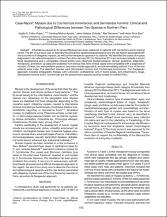| dc.contributor.author | Failoc-Rojas, Virgilio E. | |
| dc.contributor.author | Molina-Ayasta, Carolina | |
| dc.contributor.author | Salazar-Zuloeta, Jaime | |
| dc.contributor.author | Samamé, Abel | |
| dc.contributor.author | Silva-Díaz, Heber | |
| dc.date.accessioned | 2020-07-13T18:04:03Z | |
| dc.date.available | 2020-07-13T18:04:03Z | |
| dc.date.issued | 2018-01-10 | |
| dc.identifier.citation | Failoc VE., Molina C., Salazar J., Samamé A., Silva H. Case Report: Myiasis due to Cochliomyia hominivorax and Dermatobia hominis: Clinical and Pathological Differences between Two Species in Northern Peru. Am J Trop Med Hyg. 2018; 98(1): 150-153. | es_PE |
| dc.identifier.uri | https://hdl.handle.net/20.500.12727/6326 | |
| dc.description.abstract | Infestations caused by fly larvae (Myiasis) have been observed in patients with risk factors and in tropical zones. The aim of our study was to describe the clinical and epidemiological aspects and the risk factors associated with the occurrence of obligatory myiasis, as well as the therapeutic approach to patients. We identified the cases of myiasis diagnosed in two referral hospitals in northern Peru from January 2012 to December 2015 and included patients in whom larval development and a compatible clinical profile were observed. Epidemiological, clinical, analytical, diagnostic, therapeutic, and follow-up data were collected from clinical files. Nine clinical cases were compatible with a diagnosis of myiasis; of these, two were pediatric patients, one was a middle-aged adult, and six were elderly patients. Four of the nine patients were male. The identified species were Dermatobia hominis and Cochliomyia hominivorax. The therapeutic approach included antiparasitic therapy with ivermectin, antibacterial, and in some cases, anti-inflammatory drugs. Dermatobia hominis and C. hominivorax are the predominant species causing myiasis in northern Peru. | es_PE |
| dc.format.extent | pp. 150-153 | es_PE |
| dc.language.iso | eng | es_PE |
| dc.publisher | American Society of Tropical Medicine and Hygiene | es_PE |
| dc.relation.ispartof | urn:issn:1471-2393 | |
| dc.relation.ispartofseries | American Journal of Tropical Medicine and Hygiene;vol. 98, no. 1 | |
| dc.relation.uri | https://doi.org/10.4269/ajtmh.16-0437 | es_PE |
| dc.relation.uri | http://repositorio.upch.edu.pe/handle/upch/4282 | es_PE |
| dc.rights | info:eu-repo/semantics/openAccess | es_PE |
| dc.rights.uri | https://creativecommons.org/licenses/by-nc-nd/4.0/ | es_PE |
| dc.source | Repositorio Académico USMP | es_PE |
| dc.source | Universidad San Martín de Porres - USMP | es_PE |
| dc.subject | Infección por gusano barrenador | es_PE |
| dc.subject | Larva | es_PE |
| dc.subject | Parasitología | es_PE |
| dc.subject | Epidemiología | es_PE |
| dc.title | Case Report: Myiasis due to Cochliomyia hominivorax and Dermatobia hominis: Clinical and Pathological Differences between Two Species in Northern Peru | es_PE |
| dc.type | info:eu-repo/semantics/article | es_PE |
| thesis.degree.name | Medicina Humana | es_PE |
| thesis.degree.grantor | Universidad de San Martín de Porres. Facultad de Medicina Humana | es_PE |
| thesis.degree.discipline | Medicina | es_PE |
| dc.subject.ocde | https://purl.org/pe-repo/ocde/ford#3.02.00 | es_PE |








